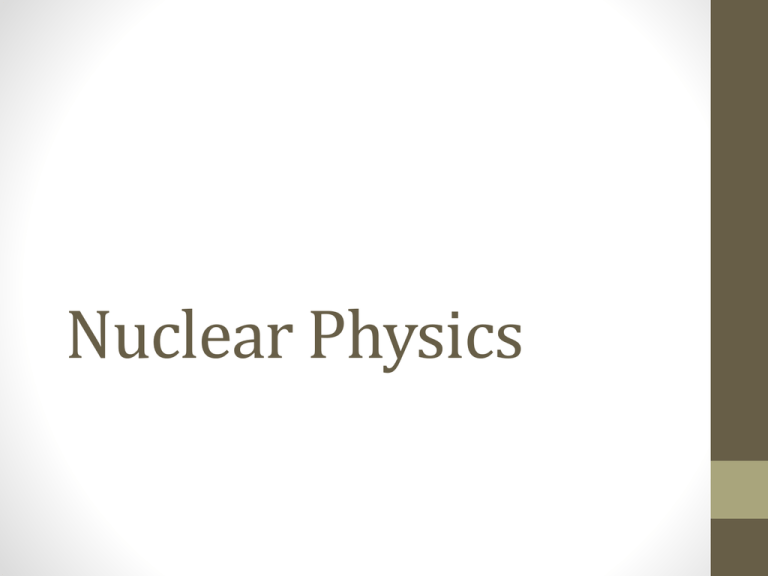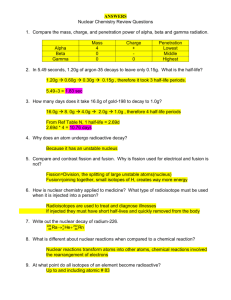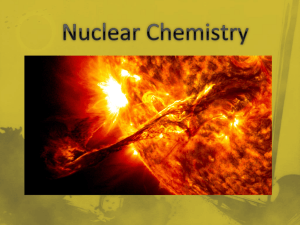Nuclear Physics
advertisement

Nuclear Physics Nuclear Physics • Nuclear Physics is the study of the atom. • This is a larger part of modern physics study, however we will only look at basic energy exchanges occurring in the atom. Subatomic Particles • We know that an atom can be broken down into smaller particles. The important particles we should know: Name Symbol Charge (C) Mass (kg) Proton p +e 1.67 x 10-27 Neutron n 0 1.67 x 10-27 Electron e- -e 9.11 x 10-31 Positron e+ +e 9.11 x 10-31 Photon γ 0 0 The Nucleus • From your studies in Chemistry you should recall that the nucleus: • is located at the center of the atom. • is made up of protons and neutrons. • tells us what element we are looking at. • We use the following model to describe the atom we are studying: 𝐴 𝑍𝑋 • A – Atomic Mass (# of protons & neutrons) • Z – Atomic Number (# of protons) • X – Chemical Symbol The Nucleus • For example, let’s look at the following atom: 12 6𝐶 • From this we know: • • • • The atom is classified as carbon It has 6 protons It has 6 neutrons If it is neutral it will have 6 electrons • An Isotope has the same number of protons, but a different number of neutrons than the most abundant form of that atom. • This change in neutrons leads to different nuclear properties Radioactivity • Radioactivity is the spontaneous emission of radiation resulting from changes in the nuclei of the atom. • Basically, it is an atom giving away extra energy that it does not need. • There are 3 different types of radioactivity: • Alpha Decay • Beta Decay • Gamma Decay Half-Life • Radioactive Half-Life is the time required for half of the radioactive substance’s mass to decay. • One use of half-life is to date things such as artifacts and fossils to determine how old they are. • The equation that we use for half-life is: 𝑁 = 𝑁𝑜 𝑡 −0.693 𝑡 1 2 𝑒 Number of Radioactive Number of Radioactive Atoms Currently Atoms Originally Present Present Time Elapsed Radioactive half-life of the specific isotope Alpha Decay • In an alpha decay, a helium nucleus is ejected from the nucleus. • The original nucleus is called the ‘parent’ nuclei • The now smaller nucleus is called the ‘daughter’ nuclei 𝐴 𝑍𝑃𝑎𝑟𝑒𝑛𝑡 = 𝐴−4 𝑍−2𝐷𝑎𝑢𝑔ℎ𝑡𝑒𝑟 + 42𝐻𝑒 • This allows the parent nuclei to become smaller which will lower the amount of energy that atom has. • This type of decay occurs with heavier elements ( Z > 52 Tellurium) Beta Decay • In beta decay, the nucleus will capture or emit electrons to change the make up of the nucleus. • There are three varieties: • Beta Emission 𝑛 𝑝 + 𝑒− + 𝜐− 𝑝 𝑛 + 𝑒+ + 𝜐 antineutrino • Positron Emission • Electron Capture neutrino 𝑝 + 𝑒− 𝑛+𝜐 • Again, the point of this is to lower the energy in the atom. • Atoms would undergo Beta Decay to achieve the optimal proton to neutron ratio. Unlike Alpha Decay, any atom can undergo Beta Decay. Gamma Decay • In gamma decay, a short wavelength form of light called a gamma ray is ejected from the nucleus. • Like Beta Decay, any atom can undergo Gamma Decay. This is the most energetic and most dangerous form of radioactivity. Rules for Radioactivity • Two quantities are conserved when radioactive decay occurs: • Conservation of Charge • Conservation of Atomic Mass • Therefore to determine if a radioactive decay is possible, be sure that the total charge stays the same and the number of nucleons (protons and neutrons) remains constant! • For example: 238 92𝑈 234 90𝑇ℎ + 42𝐻𝑒 • In this alpha decay of Uranium, it ejects a helium nucleus and leaves behind a daughter Thorium atom. Nuclear Forces • There are four fundamental forces in nature: • • • • Gravity Electromagnet Weak Nuclear Strong Nuclear • The Weak Nuclear Force is the one responsible for the radioactive decay process. It is now believed to actually be a part of the electromagnet force (which would combine them to make an electroweak force!). • The Strong Nuclear Force is the most important one of all since it is responsible for keeping the nucleus together. Strong Nuclear Force • Since most nuclei have more than one proton in them, the Electromagnet force is trying to repel/push those positive protons away from each other. • The Strong Nuclear Force opposes the Electromagnet force and keeps the nucleus from separating. • It is 100 times strong than the Electromagnet Force • It is 1,000,000,000,000,000,000,000,000,000,000,000,000,000 times stronger than Gravity. • It has a very, very small range that it can apply its force within. Nuclear Fission • Nuclear fission is the splitting of an atomic nucleus into smaller nuclei. • Radioactivity is a natural form of fission, however we only refer to fission as the man made variety using a chain reaction. • Fission releases A LOT of energy when the atom is split. • Which is why fission is used in nuclear reactors and atomic bombs. Nuclear Fission • In this example a neutron collides with a Uranium atom and starts a chain reaction: Energy Released in Fission • This brings us to Einstein’s famous equation (which you can now brag about the fact you know what it means!) Δ𝐸 = Δ𝑚𝑐 Energy released 2 Speed of light (c = 3.0 x 108) Change in mass • By figuring out how much mass has been ‘lost’ we can figure out the amount of energy that was released. • What Einstein’s equation proves is that mass and energy are the same thing in two different forms! Nuclear Fusion • Nuclear fusion is the combination of two smaller particles to make a bigger particle. • Nuclear fusion is what the sun does to create its energy (which we notice in the forms of heat and light). • Nuclear fusion has also been used as an atomic bomb, but has yet to be used to produce power in nuclear reactors. Nuclear Fusion • In this example, two Hydrogen atoms fuse to form a Helium atom:





